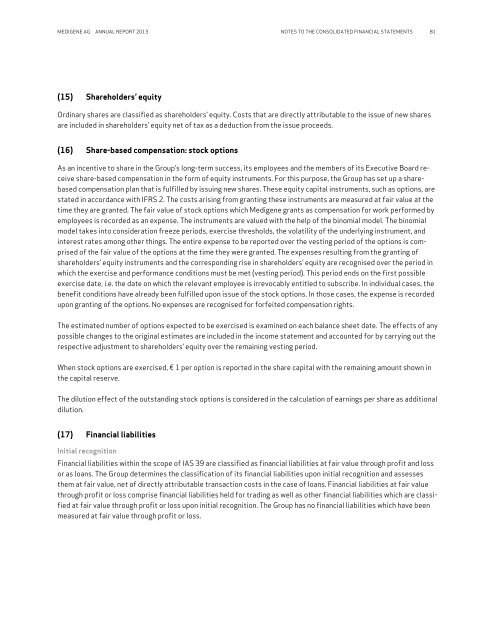mdg-annual-report-2013
mdg-annual-report-2013
mdg-annual-report-2013
You also want an ePaper? Increase the reach of your titles
YUMPU automatically turns print PDFs into web optimized ePapers that Google loves.
MEDIGENE AG ANNUAL REPORT <strong>2013</strong> NOTES TO THE CONSOLIDATED FINANCIAL STATEMENTS 81(15) Shareholders’ equityOrdinary shares are classified as shareholders’ equity. Costs that are directly attributable to the issue of new sharesare included in shareholders’ equity net of tax as a deduction from the issue proceeds.(16) Share-based compensation: stock optionsAs an incentive to share in the Group’s long-term success, its employees and the members of its Executive Board receiveshare-based compensation in the form of equity instruments. For this purpose, the Group has set up a sharebasedcompensation plan that is fulfilled by issuing new shares. These equity capital instruments, such as options, arestated in accordance with IFRS 2. The costs arising from granting these instruments are measured at fair value at thetime they are granted. The fair value of stock options which Medigene grants as compensation for work performed byemployees is recorded as an expense. The instruments are valued with the help of the binomial model. The binomialmodel takes into consideration freeze periods, exercise thresholds, the volatility of the underlying instrument, andinterest rates among other things. The entire expense to be <strong>report</strong>ed over the vesting period of the options is comprisedof the fair value of the options at the time they were granted. The expenses resulting from the granting ofshareholders’ equity instruments and the corresponding rise in shareholders’ equity are recognised over the period inwhich the exercise and performance conditions must be met (vesting period). This period ends on the first possibleexercise date, i.e. the date on which the relevant employee is irrevocably entitled to subscribe. In individual cases, thebenefit conditions have already been fulfilled upon issue of the stock options. In those cases, the expense is recordedupon granting of the options. No expenses are recognised for forfeited compensation rights.The estimated number of options expected to be exercised is examined on each balance sheet date. The effects of anypossible changes to the original estimates are included in the income statement and accounted for by carrying out therespective adjustment to shareholders’ equity over the remaining vesting period.When stock options are exercised, € 1 per option is <strong>report</strong>ed in the share capital with the remaining amount shown inthe capital reserve.The dilution effect of the outstanding stock options is considered in the calculation of earnings per share as additionaldilution.(17) Financial liabilitiesInitial recognitionFinancial liabilities within the scope of IAS 39 are classified as financial liabilities at fair value through profit and lossor as loans. The Group determines the classification of its financial liabilities upon initial recognition and assessesthem at fair value, net of directly attributable transaction costs in the case of loans. Financial liabilities at fair valuethrough profit or loss comprise financial liabilities held for trading as well as other financial liabilities which are classifiedat fair value through profit or loss upon initial recognition. The Group has no financial liabilities which have beenmeasured at fair value through profit or loss.


